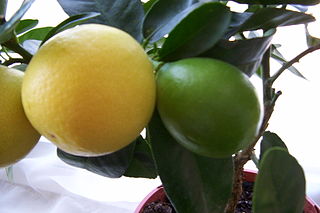
The Rutaceae is a family, commonly known as the rue or citrus family, of flowering plants, usually placed in the order Sapindales.

Murraya is a genus of flowering plants in the citrus family, Rutaceae. It is distributed in Asia, Australia, and the Pacific Islands. The center of diversity is in southern China and Southeast Asia. When broadly circumscribed, the genus has about 17 species. A narrower circumscription contains only eight species, others being placed in Bergera and Merrillia.

Walter Tennyson Swingle was an American agricultural botanist who contributed greatly to the classification and taxonomy of citrus.
Balsamocitrus is a genus of plant in family Rutaceae. It is native to Cameroon, Central African Republic, Gabon, Guinea, Republic of the Congo, and Uganda.
Limnocitrus is a genus of plant in the family Rutaceae with one species, Limnocitrus littoralis. It is native to Vietnam and Indonesia, where it is found on the island of Java in Jepara. In traditional Vietnamese medicine different parts of the plant have been used as an expectorant, antitussive product, for exudation, and the treatment of colds and fevers.
Merrillia is a monotypic genus of flowering plants in the citrus family, Rutaceae, containing the single species Merrillia caloxylon. Its English language common names include flowering merrillia, katinga, and Malay lemon. In Malaysia it is called ketenggah and kemuning gajah. The species is native to Malaysia, Thailand, and Sumatra in Indonesia.
Citrus neocaledonica, synonym Oxanthera neocaledonica, the large leaf oxanthera, is a species of plant in the family Rutaceae. It is endemic to New Caledonia.
Citrus undulata, synonym Oxanthera undulata, the wavy-leaf oxanthera, is a species of plant in the family Rutaceae. It is endemic to New Caledonia. Oxanthera undulata is classified as critically endangered by the IUCN.
Pleiospermium longisepalum is a species of plant in the family Rutaceae. It is endemic to Borneo where it is confined to Sabah.

Aurantioideae is the subfamily within the rue and citrus family (Rutaceae) that contains the citrus. The subfamily's center of diversity is in the monsoon region of eastern Australasia, extending west through South Asia into Africa, and eastwards into Polynesia.
Clymenia is a small genus of flowering plants in the family Rutaceae with two species. The genus is often included in Citrus.

Atalantia is a genus of flowering plants in the citrus family, the Rutaceae.

Feroniella is a genus in the family Rutaceae, the only species being Feroniella lucida. The genus is placed within Citrus by some sources, with the species becoming Citrus lucida. Feroniella lucida is a fruit-bearing tree native to Cambodia, Laos, Thailand, Vietnam and the island of Java, Indonesia.

Aeglopsis is a genus of flowering plants belonging to the family Rutaceae.

Swinglea is a monotypic genus of flowering plants belonging to the family Rutaceae. It only contains a single species, Swinglea glutinosa.
Wenzelia is a genus of flowering plants belonging to the family Rutaceae.
Pamburus is a genus of flowering plants belonging to the family Rutaceae.

Paramignya is a genus of flowering plants belonging to the family Rutaceae.

Bergera is a genus of flowering plants in the family Rutaceae. It has been included in Murraya as M. sect. Bergera. Species that may be placed in the genus are native from India through southeast Asia eastwards to China and Taiwan southwards to Malesia and New Caledonia. The curry tree, Bergera koenigii, is one of the better known species.










